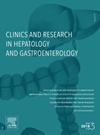Liver fibrosis evaluation in patients with psychiatric diseases
IF 2.4
4区 医学
Q2 GASTROENTEROLOGY & HEPATOLOGY
Clinics and research in hepatology and gastroenterology
Pub Date : 2025-06-18
DOI:10.1016/j.clinre.2025.102636
引用次数: 0
Abstract
Introduction: Mental illnesses and psychiatric disorders are public health problems, with an increasing prevalence. Life expectancy of patients is compromised by comorbid somatic illnesses, including liver diseases. Screening for liver fibrosis in this population is challenging.
Materials & Methods: We assessed liver fibrosis using liver stiffness (LS) measurement by FibroScan® in a large cohort of patients with severe psychiatric disorders receiving psychotropic medications for at least two years. Liver steatosis was evaluated using the Controlled Attenuation Parameter™ (CAP).
Results: 355 patients were prospectively included. Advanced fibrosis (LS >8 kPa) prevalence was 6 %. In univariate analysis, advanced fibrosis was associated with high blood pressure (p < 0.001), high ferritin concentration (p = 0.028), and psychotropic drug exposure (p = 0.036). In multivariate analysis, high blood pressure only remained significant (p = 0.002). 34.9 % of patients had significant steatosis (CAP >275 dB/m). In univariate analysis, steatosis was associated with sleep apnea syndrome (p = 0.016), past alcohol dependence (p = 0.013), high body mass index (BMI), type 2 diabetes (p = 0.003), elevated triglycerides (p < 0.001), metabolic syndrome (p < 0.001), metabolic dysfunction-associated liver disease (p < 0.001), and high ferritin concentration (p = 0.008). In multivariable analysis, high BMI and elevated triglycerides remained significant.
Conclusion: Psychiatric patients are at risk of liver fibrosis and steatosis. Systematic screening for liver diseases should be required. Further studies are needed to determine the best strategies for prevention and treatment.
精神疾病患者肝纤维化的评价。
前言:精神疾病和精神障碍是公共卫生问题,发病率越来越高。患者的预期寿命因共病躯体疾病(包括肝病)而受到损害。在这一人群中筛查肝纤维化具有挑战性。材料与方法:我们在一组接受精神药物治疗至少两年的严重精神疾病患者中,使用FibroScan®的肝硬度(LS)测量来评估肝纤维化。使用控制衰减参数™(CAP)评估肝脂肪变性。结果:前瞻性纳入355例患者。晚期纤维化(LS bbb80 kPa)患病率为6%。在单变量分析中,晚期纤维化与高血压相关(p275 dB/m)。在单因素分析中,脂肪变性与睡眠呼吸暂停综合征(p=0.016)、既往酒精依赖(p=0.013)、高体重指数(BMI)、2型糖尿病(p=0.003)、甘油三酯升高(p)相关。需要对肝脏疾病进行系统筛查。需要进一步的研究来确定预防和治疗的最佳策略。
本文章由计算机程序翻译,如有差异,请以英文原文为准。
求助全文
约1分钟内获得全文
求助全文
来源期刊

Clinics and research in hepatology and gastroenterology
GASTROENTEROLOGY & HEPATOLOGY-
CiteScore
4.30
自引率
3.70%
发文量
198
审稿时长
42 days
期刊介绍:
Clinics and Research in Hepatology and Gastroenterology publishes high-quality original research papers in the field of hepatology and gastroenterology. The editors put the accent on rapid communication of new research and clinical developments and so called "hot topic" issues. Following a clear Editorial line, besides original articles and case reports, each issue features editorials, commentaries and reviews. The journal encourages research and discussion between all those involved in the specialty on an international level. All articles are peer reviewed by international experts, the articles in press are online and indexed in the international databases (Current Contents, Pubmed, Scopus, Science Direct).
Clinics and Research in Hepatology and Gastroenterology is a subscription journal (with optional open access), which allows you to publish your research without any cost to you (unless you proactively chose the open access option). Your article will be available to all researchers around the globe whose institution has a subscription to the journal.
 求助内容:
求助内容: 应助结果提醒方式:
应助结果提醒方式:


